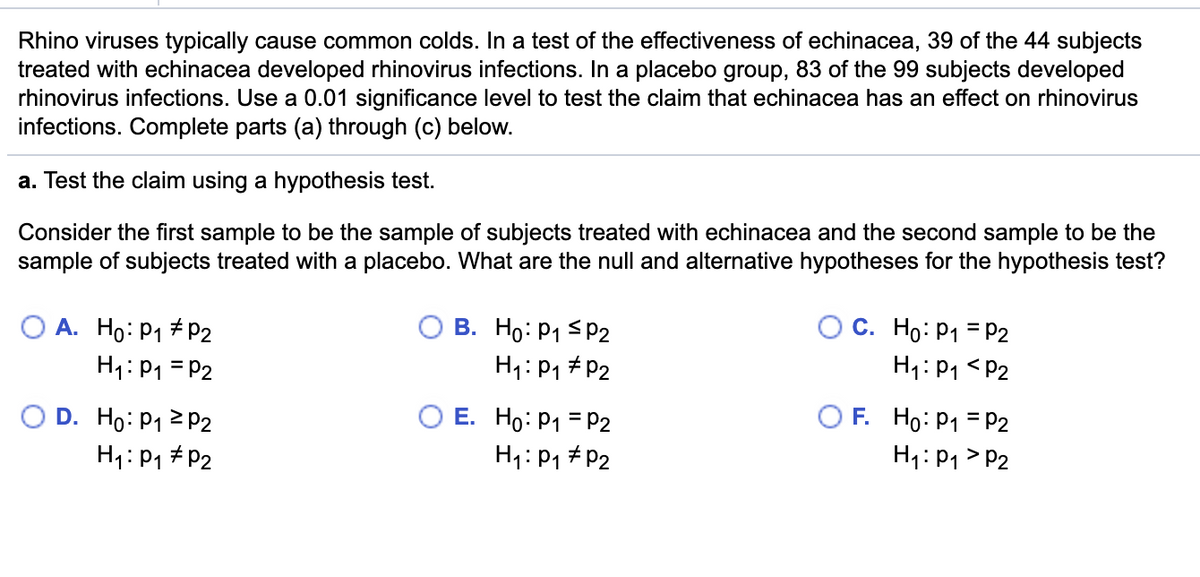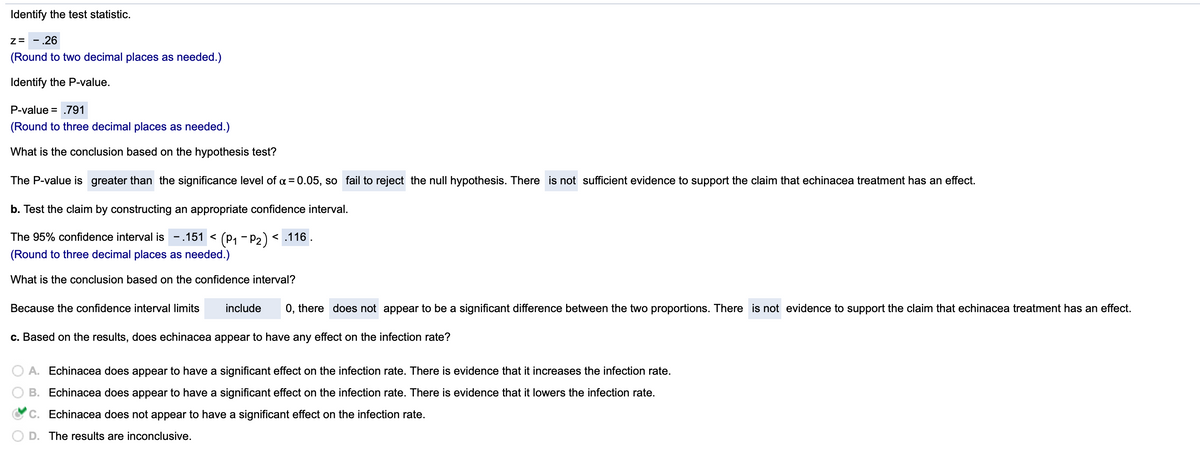Rhino viruses typically cause common colds. In a test of the effectiveness of echinacea, 39 of the 44 subjects treated with echinacea developed rhinovirus infections. In a placebo group, 83 of the 99 subjects developed rhinovirus infections. Use a 0.01 significance level to test the claim that echinacea has an effect on rhinovirus infections. Complete parts (a) through (c) below. a. Test the claim using a hypothesis test. Consider the first sample to be the sample of subjects treated with echinacea and the second sample to be the sample of subjects treated with a placebo. What are the null and alternative hypotheses for the hypothesis test? O A. Ho: P1 # pP2 H1:P1 = P2 OC. Ho: P1 = P2 H1: P1 P2 H1: P1 #P2
Rhino viruses typically cause common colds. In a test of the effectiveness of echinacea, 39 of the 44 subjects treated with echinacea developed rhinovirus infections. In a placebo group, 83 of the 99 subjects developed rhinovirus infections. Use a 0.01 significance level to test the claim that echinacea has an effect on rhinovirus infections. Complete parts (a) through (c) below. a. Test the claim using a hypothesis test. Consider the first sample to be the sample of subjects treated with echinacea and the second sample to be the sample of subjects treated with a placebo. What are the null and alternative hypotheses for the hypothesis test? O A. Ho: P1 # pP2 H1:P1 = P2 OC. Ho: P1 = P2 H1: P1 P2 H1: P1 #P2
Glencoe Algebra 1, Student Edition, 9780079039897, 0079039898, 2018
18th Edition
ISBN:9780079039897
Author:Carter
Publisher:Carter
Chapter10: Statistics
Section10.6: Summarizing Categorical Data
Problem 30PPS
Related questions
Question
p7

Transcribed Image Text:Rhino viruses typically cause common colds. In a test of the effectiveness of echinacea, 39 of the 44 subjects
treated with echinacea developed rhinovirus infections. In a placebo group, 83 of the 99 subjects developed
rhinovirus infections. Use a 0.01 significance level to test the claim that echinacea has an effect on rhinovirus
infections. Complete parts (a) through (c) below.
a. Test the claim using a hypothesis test.
Consider the first sample to be the sample of subjects treated with echinacea and the second sample to be the
sample of subjects treated with a placebo. What are the null and alternative hypotheses for the hypothesis test?
О А. Но: Р1 7 P2
H1: P1 = P2
O C. Ho: P1 = P2
H1: P1 <P2
B. Ho: P1 <P2
H1: P1 # P2
D. Ho: P1 2 P2
H1: P1 #P2
F. Ho: P1 = P2
H1: P1 > P2
E. Ho: P1 = P2
H1: P1 # P2

Transcribed Image Text:Identify the test statistic.
z= - .26
(Round to two decimal places as needed.)
Identify the P-value.
P-value = .791
(Round to three decimal places as needed.)
What is the conclusion based on the hypothesis test?
The P-value is greater than the significance level of a = 0.05, so fail to reject the null hypothesis. There is not sufficient evidence to support the claim that echinacea treatment has an effect.
b. Test the claim by constructing an appropriate confidence interval.
The 95% confidence interval is
-.151 < (P1 - p2) < .116 .
(Round to three decimal places as needed.)
What is the conclusion based on the confidence interval?
Because the confidence interval limits
include
0, there does not appear to be a significant difference between the two proportions. There is not evidence to support the claim that echinacea treatment has an effect.
c. Based on the results, does echinacea appear to have any effect on the infection rate?
A. Echinacea does appear to have a significant effect on the infection rate. There is evidence that it increases the infection rate.
B. Echinacea does appear to have a significant effect on the infection rate. There is evidence that it lowers the infection rate.
C. Echinacea does not appear to have a significant effect on the infection rate.
D. The results are inconclusive.
Expert Solution
This question has been solved!
Explore an expertly crafted, step-by-step solution for a thorough understanding of key concepts.
This is a popular solution!
Trending now
This is a popular solution!
Step by step
Solved in 2 steps

Knowledge Booster
Learn more about
Need a deep-dive on the concept behind this application? Look no further. Learn more about this topic, statistics and related others by exploring similar questions and additional content below.Recommended textbooks for you

Glencoe Algebra 1, Student Edition, 9780079039897…
Algebra
ISBN:
9780079039897
Author:
Carter
Publisher:
McGraw Hill

College Algebra (MindTap Course List)
Algebra
ISBN:
9781305652231
Author:
R. David Gustafson, Jeff Hughes
Publisher:
Cengage Learning

Glencoe Algebra 1, Student Edition, 9780079039897…
Algebra
ISBN:
9780079039897
Author:
Carter
Publisher:
McGraw Hill

College Algebra (MindTap Course List)
Algebra
ISBN:
9781305652231
Author:
R. David Gustafson, Jeff Hughes
Publisher:
Cengage Learning